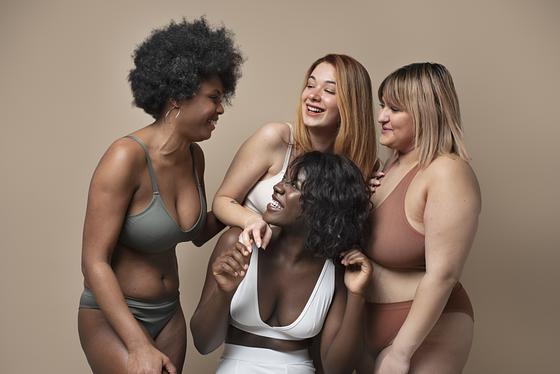Since the inception of its roots in the Fat Acceptance (FA) Movement in the 1960s, the body positivity movement was created and surged in popularity in the 2010s as a response to the pro-anorexia, heroin chic-ness of the 90s and the early 2000s. The movement stood as something to challenge this toxic norm of an obsession with thinness, promoting an acceptance and appreciation for a diversity of body types and sizes. It also promotes self-love and respect for one’s body, regardless of shape or size.
What could be possibly wrong with that? While it sounds ideal in theory, in practice it has not lived up to that expectation, and in 2023, this movement is slowly going sour in pop culture and society. The question of whether body positivity is toxic is one that requires a nuanced discussion of why it is deemed toxic, and how to move forward.
Body Positivity= Toxic Positivity?
Body positivity is a subset of toxic positivity. That seems loaded, right? According to Psychologist Susan Albers, PsyD, “some feel that it blames people for how they feel based on their mindset.
It can also push people into trying to feel something that they don’t.” Body positivity, while an admirable concept, can and does enforce many proponents of toxic positivity. At the end of the day, we don’t all feel good about our bodies all the time, even if some of our bodies fit the conventional beauty standard. Sometimes we can’t bring ourselves to admit to the fact that there are moments where we feel insecure after spending a bit too much time scrolling through TikTok, and sometimes wish we had a little less fat here or a little more somewhere else. Admitting this, though, is admitting that we’re human, which is something that body positivity leaves little room for with its flower-encrusted slogans and emphasis on self-love. Aside from this, studies have shown that in men and women, body dissatisfaction has not necessarily decreased with the rise of body positivity. With social media use, and now cosmetic surgery on the rise, more people are left even more self-conscious, basing their entire self-esteem on looks and outcomes of plastic surgery.

How much inclusion is too much?
Another criticism that tends to be brought up is both its exclusionary and co-opting nature. Paradoxical? I’ll explain.
Let’s take the first half. To some, body positivity is not an inclusive enough movement, lacking in voices from older people, people of ethnic minorities and LGBT+ people. This is not one of the criticisms I hold against the movement, but it is still important to mention. An analysis of almost 250 Instagram posts showed that 67% of posts featured only white women, and lacking in posts from older people, people of color and gender non-conforming people. I agree to the point that body positivity, even from its beginnings in the fat acceptance movement, has always been lacking in men. To the other half- co-opting. A common criticism made of body positivity is that it has been co-opted by all bodies and is losing its radical touch. In the wise words of Lizzo: “people are finally celebrating medium and small girls and people who occasionally get rolls, (but) fat people are still getting the short end of this movement.” This comment, while obviously well-intended, is leaning into the trend of skinny-shaming, where it is believed that because people who are thinner are more conventionally attractive, they are not allowed the grace of body dissatisfaction. The inclusion of medium and skinnier girls has caused the movement, in some opinions, to lose its radical touch. According to The Conversation, referencing Amanda Mull’s piece Body Positivity is a Scam, “ in divorcing itself from its radical past, the movement ignores the structural reasons that lead to negative body image, such as gendered inequalities and systems of oppression.”

Is it Really Healthy, Anyway?
One other criticism observed regarding the body positivity movements, fat acceptance and related movements, is the concerns for people’s health. Many, including myself, argue that the movement ignores the risks associated with carrying an excessive amount of body weight, and the normalization of unhealthy behaviors that lead to obesity. Almost 2.3 billion children and adults are living with obesity in our world today, and with this in mind, whether or not someone looks beautiful while obese should not take priority to the health of that person.
Complications from obesity kill 4.72 million people yearly, and obesity in adulthood has been associated with a decrease in life span by 6+ years . While, yes, you don’t have to be skinny to be healthy, and being underweight is unhealthy, there are no health benefits to being obese, unless clogged arteries, high blood pressure, lipoedema, sleep apnea and many more are considered positives for health. Moderation is necessary, especially in our eating and dietary choices. Encouraging a culture of gluttony in the name of body positivity is not the solution that is needed to the problem body positivity stands to answer. Consistent exercise and water intake, and moderating the ingestion of certain foods (ones high in cholesterol, saturated fats, trans fats and added sugars) is beneficial to a healthy body. There are some people who cannot, however, control weight gain and loss in their bodies due to diseases like endometriosis, PCOS, or issues with their metabolism, physical ability, hormones or thyroid glands. However, for those who do have control over their weight, it is important to strike that balance, and yes, it is easier said than done.

The question of whether body positivity is toxic or not requires us to open up conversation to viewpoints that differ from ours, and create solutions that may not be perfect, but try to pick up the pace where body positivity lacks. The next question would then be: so what’s the alternative? If not this, then what?
I do not have the answer to that, but, the body neutrality movement might be answering that question. I still find some criticisms of body neutrality, and some of the criticisms of body positivity may apply to neutrality as well. I think the answer to this question may lie in a hybrid of the two movements. Both have their strengths and benefits, and taking the best of both movements may make for a stronger, more fulfilling and nuanced movement. As for the verdict, the jury finds body positivity……..toxic but not toxic?
Image Attributions:
Image by Freepik <a href="https://www.freepik.com/free-vector/low-self-esteem-woman-looking-into-mirror_10631703.htm#query=body%20dysmorphia&position=5&from_view=search&track=ais">Freepik</a>
Image by Freepik<a href="https://www.freepik.com/free-photo/medium-shot-different-women-posing-together_22068713.htm#query=body%20positivity&position=1&from_view=search&track=ais">Freepik</a>
Image by <a href="https://www.freepik.com/free-vector/low-self-esteem-woman-looking-into-mirror_10631703.htm#query=body%20dysmorphia&position=5&from_view=search&track=ais">Freepik</a>




